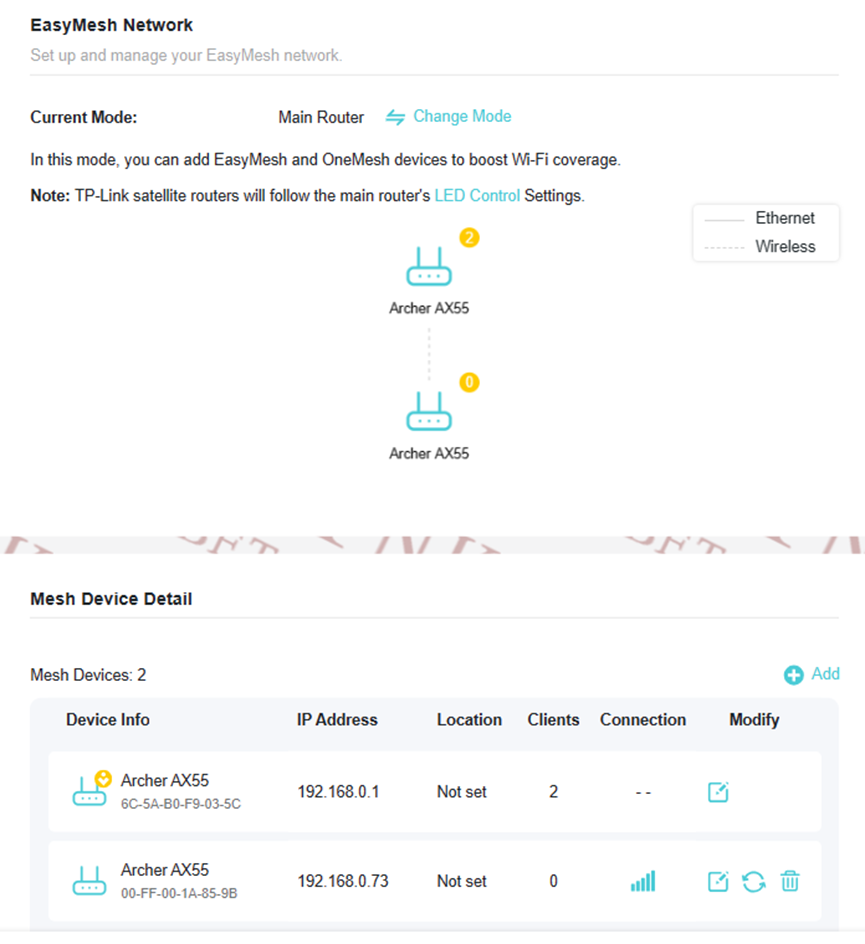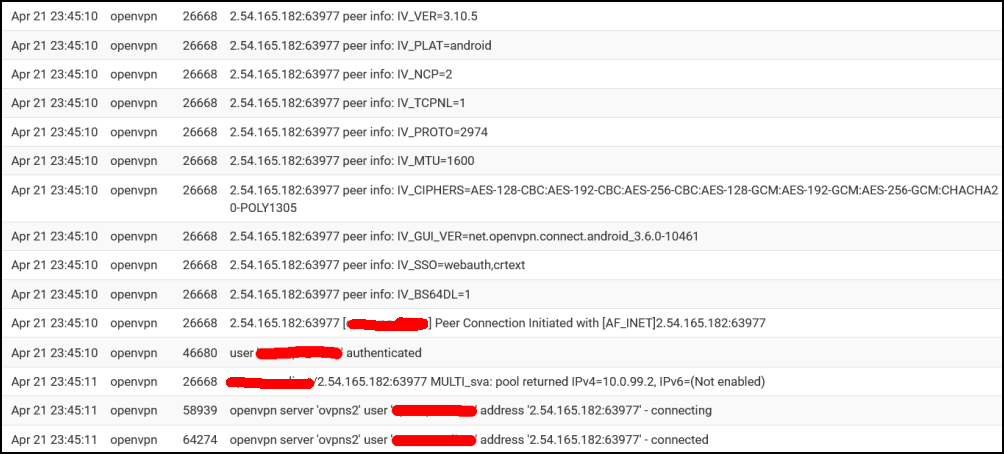Early Access Pre-release Firmware for Archer AX53/AX58 Supports EasyMesh in AP Mode, Ethernet Backhaul, ECO Mode
Updated on Oct 23th, 2025:
The official version 1.4.3 Build 20250314 is gradually rolling out, and users can check for updates on the AX58's web interface or through the Tether App and install the latest version. We strongly recommend upgrading to this version to improve the overall experience.
Updated on Jun 3, 2025:
The official version 1.4.3 Build 20250314 is gradually rolling out, and users can check for updates on the AX53's web interface or through the Tether App and install the latest version. We strongly recommend upgrading to this version to improve the overall experience.
Users can also get a direct download link of the new version from the website as follows:
https://www.tp-link.com/support/download/archer-ax53/v1/#Firmware
This thread will be locked for further comments then. Please start a new thread to open a discussion if you have any questions.
---------------------------------------------------------------------------------------------------------------------------------------
Hello Everyone,
We're thrilled to announce the release of the pre-release firmware for Archer AX53/AX58 V1. This firmware update introduces several exciting new functions and improvements to enhance your experience including Ethernet Backhaul, EasyMesh in AP mode, Satellite Router Management, ECO Mode, etc. We encourage you to try out this version of firmware and take advantage of the following features. Your feedback and suggestions are greatly appreciated.
New Features and Modifications:
1. Added Ethernet Backhaul for EasyMesh.
2. Added EasyMesh feature in AP mode.
3. Enhanced EasyMesh Satellite Router Management via satellite router web interface.
4. Added EasyMesh Network Topology to gain a clear understanding of your EasyMesh network's structure.

5. Added ECO mode on Advanced->System->ECO Mode page.
When working in Power-Saving Mode or Ultra Power-Saving Mode, your router will reduce the power consumption to save power, please note that your network speed and coverage will be reduced as well.

6. Added IoT Network.
7. Enhanced Wi-Fi Schedule to enjoy more flexibility by setting separate schedules for 2.4GHz and 5GHz Wi-Fi bands.

8. Added isolation of Guest Network and Main Network in AP mode.
9. Added Language options on the top of the web interface.
10. Added support for VPN Client.
11. Added support for WireGuard.
12. Added OpenVPN Server TAP Mode. Introducing TAP Mode in OpenVPN Server for AX55 V1 Router
Note: It requires your OpenVPN Client supporting TAP Mode as well, or you will not be able to connect the VPN Server successfully
13. Added new functions to the Tether App: EasyMesh, OpenVPN Server/Client, Eco Mode, Wireless Schedule, Guest Portal Network
Note: please use the new Tether App to experience those new features: New UI for 11AX Routers on Tether App 4.3 version is Ready for Trial






14. Added User Experience Improvement Program (UEIP).
Participate in our UEIP during the Quick Setup process, or enable/disable it later on the Advanced->System->About page. Your feedback will help us enhance the product.

15. Improved client type identification accuracy.
16. Optimized the overall system stability and performance.
Firmware Download:
Before the Upgrade
(1) IMPORTANT!: Once upgraded to the 1.4.x firmware, you CANNOT downgrade back to the 1.3.x or 1.2.x version.
(2) Please be sure you have read the Beta Test Agreement before upgrading the pre-release firmware!
(3) For the sake of insurance, it's always recommended to save a copy of the router Backup Config file before upgrading or downgrading.
(4) This pre-release firmware for Archer AX53/AX58 V1 can be applied to all versions (EU/US/AU/KR/etc.).
(5) You may follow the guide to upgrade the firmware of your router. How to Upgrade the Firmware on the TP-Link Wi-Fi Routers.
(6) The screenshots in this article are taken from the web GUI or Tether App of Archer AX55 V1 for reference.
Direct Firmware Download Link
| Archer AX53/AX58_V1 | Archer AX53/AX58_V1_1.4.3 Build 20250314 (Pre-release Firmware) UPDATED |
Additional Information
As always, we value your feedback. If somehow you encounter an issue during or after the router firmware upgrade, it's suggested to comment below with the following info. Your input helps us continue improving and providing the best products and support.
- Provide a detailed network layout, including how the devices are connected, especially if there are EasyMesh satellite devices.
- Detailed issue description, and provide more information on the specific conditions that seem to trigger the problem.
Thank you for your continued support and for being part of our community.
Update Log
Apr 11th, 2025:
Update to provide a new 1.4.3 pre-release version.
Related Articles
Product List of Wi-Fi Routers that Support EasyMesh Ethernet Backhaul
What is EasyMesh and how does it work with TP-Link routers and extenders?
EasyMesh Is Available When Wi-Fi Routers Work in AP Mode as A Controller
How to Build an Ethernet Backhaul Using Two EasyMesh Routers
Introducing TAP Mode in OpenVPN Server for AX55 V1 Router
New UI for 11AX Routers on Tether App 4.3 version is Ready for Trial
- Copy Link
- Subscribe
- Bookmark
- Report Inappropriate Content
- Copy Link
- Report Inappropriate Content
- Copy Link
- Report Inappropriate Content
- Copy Link
- Report Inappropriate Content
hello,
I have two AX53 routers. One is v1 and the other is v2. They are located at two different places. I've tried to connect the v2 router as an OpenVPN client to a remote pfSense VPN server and everything worked fine.
I've upgraded the v1 router to the 1.4.1 and today to the 1.4.3 firmware. Tried to connect to the same VPN server using the same .opvn file but the status keeps saying "Connecting".
Any suggestions?
- Copy Link
- Report Inappropriate Content
That means it requires a firmware update to support EasyMesh if it is an Onemesh model.
However, there is no newer firmware for Archer C2600 V2 to support EasyMesh.![]()
- Copy Link
- Report Inappropriate Content
eshabi wrote
hello,
I have two AX53 routers. One is v1 and the other is v2. They are located at two different places. I've tried to connect the v2 router as an OpenVPN client to a remote pfSense VPN server and everything worked fine.
I've upgraded the v1 router to the 1.4.1 and today to the 1.4.3 firmware. Tried to connect to the same VPN server using the same .opvn file but the status keeps saying "Connecting".
Any suggestions?
@eshabi Are the two AX53s connecting to the internet through different Internet Providers? Would it be possible or convenient to swap their locations to determine if the issue is related to internet settings or specific hardware/firmware?
In the LAN/local network of the AX53 V1, please running OpenVPN Client software on your computer or phone to see if you can successfully connect to the pfSense VPN server.
Additionally, please email us (support.forum@tp-link.com) the .opvn file you imported into both AX53s for further analysis.
- Copy Link
- Report Inappropriate Content
I gotta say that this is not what I read or interpet from the text.
I.e.
It would be what you mean if it would say: "Make sure your router supports EasyMesh. A firmware update may be req...."
But it is what it is (and it's unfortunate).
- Copy Link
- Report Inappropriate Content
@eshabi Are the two AX53s connecting to the internet through different Internet Providers? Would it be possible or convenient to swap their locations to determine if the issue is related to internet settings or specific hardware/firmware?
In the LAN/local network of the AX53 V1, please running OpenVPN Client software on your computer or phone to see if you can successfully connect to the pfSense VPN server.
Additionally, please email us (support.forum@tp-link.com) the .opvn file you imported into both AX53s for further analysis.
@Kevin_Z The internet providers of the two AX53 are different. The v1 router uses the same provider as the OpenVPN server. Swapping the routers is not really an option.
I did run the OpenVPN client on my phone using the v1 router's Wi-Fi network and it connected with no problem to the server.
Next is my (censored) opvn file:
dev tun
persist-tun
persist-key
data-ciphers AES-256-GCM:AES-128-GCM:CHACHA20-POLY1305:AES-256-CBC
data-ciphers-fallback AES-256-CBC
auth SHA256
tls-client
client
resolv-retry infinite
remote ?????.getmyip.com 1194 udp4
setenv opt block-outside-dns
nobind
verify-x509-name "OpenVPN_Server_Cert" name
auth-user-pass
remote-cert-tls server
explicit-exit-notify
redirect-gateway defl
<ca>
-----BEGIN CERTIFICATE-----
?????
-----END CERTIFICATE-----
</ca>
<cert>
-----BEGIN CERTIFICATE-----
?????
-----END CERTIFICATE-----
</cert>
<key>
-----BEGIN PRIVATE KEY-----
?????
-----END PRIVATE KEY-----
</key>
key-direction 1
<tls-auth>
#
# 2048 bit OpenVPN static key
#
-----BEGIN OpenVPN Static key V1-----
?????
-----END OpenVPN Static key V1-----
</tls-auth>
- Copy Link
- Report Inappropriate Content
Hi,
I have not used pfSense myself, but I presume it should allow you to look at the log messages of the VPN server, just like in most Unix-like operating systems.
If so, then looking at the VPN server's messages in the pfSense's logs should give you an idea what is going on. Just compare a "good" log of a connection made by the AX53 V2 to a "bad" log of the connection attempt of the AX53 V1.
Unfortunately, TP-Link's routers don't give away any VPN logging information, which makes troubleshooting VPN connection problems from the router's side extremely difficult or impossible.
- Copy Link
- Report Inappropriate Content
I followed your suggestion and when a “good” VPN connection was established, I saw several log entries (attached).
When I tried to connect the AX53 v1 router as the OpenVPN client, there were no log entries on the server. It looks like no connection attempt was made.

- Copy Link
- Report Inappropriate Content
Information
Helpful: 1
Views: 43729
Replies: 212

